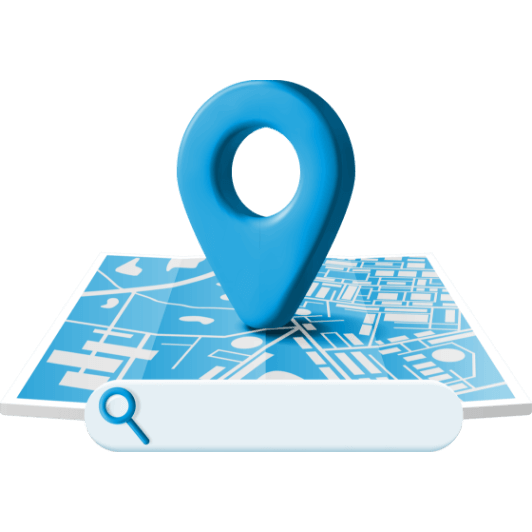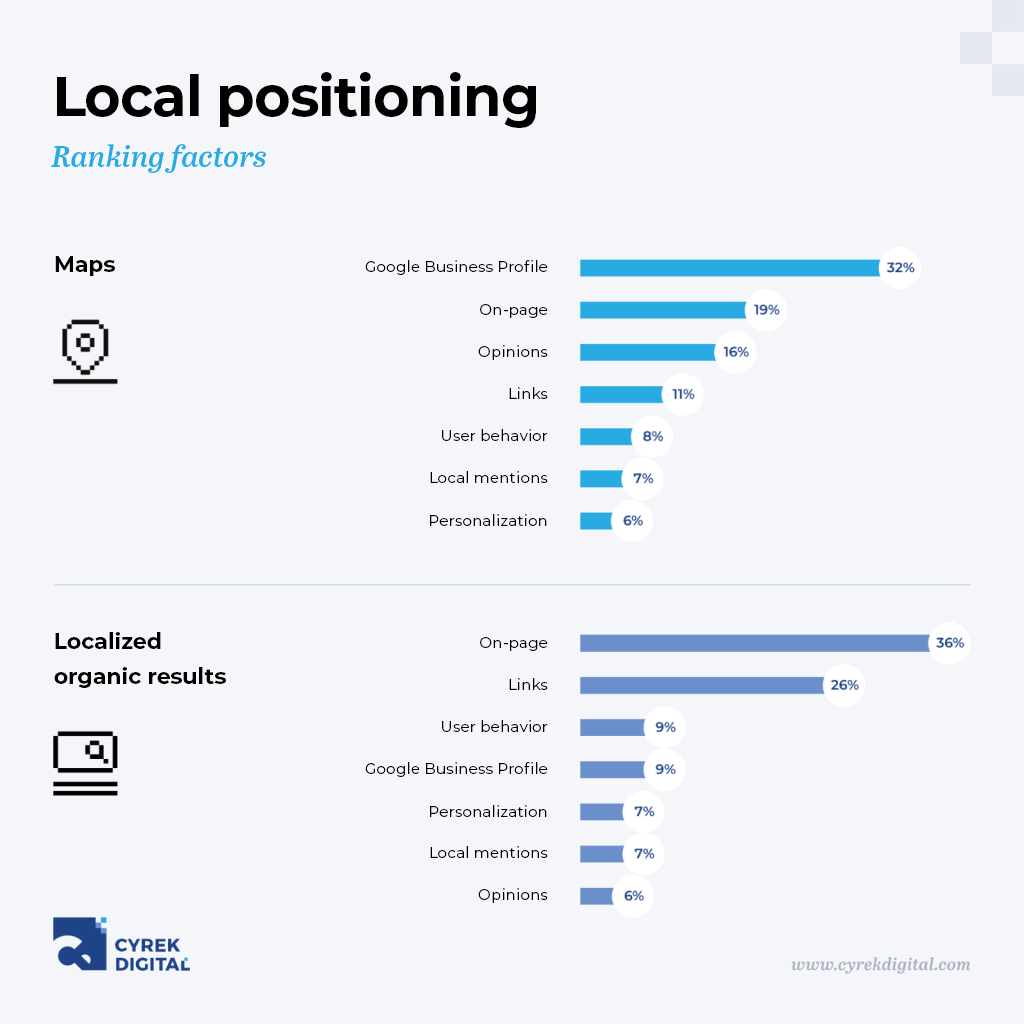
Local positioning – what it is and what it involves

Local positioning is an area of marketing that aims to attract customers from geolocalised search results. It is particularly important for companies that operate in a small area, usually a specific city or province. How does local SEO work and how does it differ from the global one?
In this article you will find out:
- What is local positioning and what does it involve?
- How to choose keywords for local positioning?
- What influences local positioning?
Table of contents



Local positioning – the basics
From this chapter you will learn how local positioning works, how it differs from non-local positioning, and who should include local positioning in their marketing strategy.

Local positioning, also known as local SEO, is an action aimed at getting a website to rank high in Google for phrases related to a given area (usually a city or province).
Local positioning is a search engine optimisation strategy that focuses on increasing a company’s visibility in search results in a specific geographical location. This can include both on-page (for example, improving content and metadata on the company’s website to reflect the location) and off-page (for example, optimising the Google My Business profile, collecting local links, managing online reviews).
Definition of local SEO
Local SEO is important because many people use search engines to find local businesses.
According to Google data:
- 30% of all searches on mobile devices are related to location.
- 78% of people who search for something nearby on their phones visit a business within a day.
- 28% of searches for something nearby result in a purchase.
In short, customers are looking for your business. If you’re not there, you’re leaving money on the table.
Local positioning always refers to a specific location. In its case, keywords usually consist of keywords in the form of the name of a product or service and a specific location, e.g. ‘hairdresser Warsaw Praga’ or ‘SEO Krakow’. Global positioning, on the other hand, refers to given phrases without indicating the location. The word “hairdresser” will refer to all hairdressers in the world.
There is also regional positioning. As the name suggests, it refers to regions – in Poland these may be, for example, voivodeships, historical or geographical regions. Regional positioning is not always relevant, because after entering the phrase “hairdresser Mazowieckie”, Google will usually suggest hairdressers near the user on the basis of detailed geolocalisation. It will work well, for example, in tourism (e.g. the phrase “Mazury accommodation”) and countries such as the USA, where regions have considerable autonomy.
Local SEO – how does it differ from broad SEO?
Is local SEO different from classic (broad) SEO? Yes and no. In each case, care must be taken to properly optimise the website and link building must be implemented.
The difference lies in the objective we aim to achieve. In the case of local SEO, the most important thing is visibility in the local search results. And therefore traffic and customers from a specific location. It is therefore necessary to choose the right keywords. Keywords that include the name of the town, district or province. What else is an absolute must for local SEO? Setting up and optimising a Google Business Card (otherwise known as a NAP business card) My Business is of great importance, because it is the one that appears in local search results just below the paid Google Ads results.
Google local positioning – for whom
Local SEO is one of the key elements of internet marketing for entrepreneurs who operate in a regional market.
This is most often a city, a province or, in the case of agglomerations, even a district. Who, above all, should invest in local SEO? Without a doubt, business owners such as:
- restaurants, bars, discos,
- stationary shops,
- hotels and guest houses,
- hairdressing/massage/beauty salons,
- florists,
- accountancy offices,
- law firms,
- private clinics (doctors),
- renovation and construction companies,
- fitness clubs/gyms.
It is all about the products and services that users are looking for in their immediate area. The benefits of visibility in local search results are obvious. A business that ranks high in the search results automatically becomes the first choice for Google users.
An example? A faucet failure in your flat.
Assuming we don’t have the number for a proven ‘handyman’ on our mobile phone, we reach for our mobile phone to quickly find a professional. This usually limits our search to the first search results.
The conclusion? The highest traffic and the most customers are gained by those companies that are ranked highest in Google. The lower the position, the less traffic, and if a site is outside the top10, i.e. further down than the first page of search results, it can count on single hits that rarely lead to conversions.
Local positioning is made possible precisely by geolocalisation.
In a nutshell, the fact is that the location of the device on which we use Google for some phrases (local, e.g. “restaurant”) influences the search results that are displayed. If you are in Kraków and type in the phrase “American cuisine”, you will see different suggestions than in Wrocław. Interestingly, location also matters when adding reviews to Google Moja Firma. The most valuable reviews are those from the same location as the company being reviewed.
However, this does not mean that a person from Kraków, who types the phrase “SEO” into Google (without adding “Kraków”), will see the same results as a user from Wrocław. This is because the search engine adjusts the results based on the geolocation of the device used by the searcher. As a result, the search results will include pages of local companies.
Interestingly, a resident of Krakow will see slightly different results than a user who is not in the city, but types in a typically local key phrase, i.e. including “Krakow”. This is the result of a combination of geolocalisation and personalisation of search results – Google provides search results based, among other things, on the user’s previous activity and preferences.
Local position – how to check it?
How do I check my position for localised phrases? There are several tools available on the market that allow you to check the position of your website in the search engine, both free and paid ones. Tools such as Ad Preview from Google will also work well for this. Among the paid applications, you can mention Senuto, for example. You can force a change of location using search engine functionalities and widgets in the search results:
Location-selectable IP change tools like a programme with the cute name HideMyAss can also be useful.
Local positioning – finding keywords
How do you choose keywords that are likely to bring local customers to your business? This is not as obvious as it may seem. From this chapter, you’ll learn how to find and identify well the keywords that will bring you better local SEO results.

In local SEO, keywords are selected that include the location – city or region, less commonly province or district. The chosen phrases should be used to optimise the site, create landing pages and content marketing. The frequency with which the keyword appears in the text is important, as is the length of the content itself. However, it is also important to bear in mind the content layer of the text and not to over saturate the key phrases, ensuring that they are always in a natural context.
Most people do not think about the different ways in which others may search for what they do.

Find keywords related to your services and business profile
For example, if you are an electrician, some customers will find you by typing ‘plumber warszawa’ or ‘plumber cheap’, ‘plumber price list’ into Google. But others will search for queries related to specific services, such as “drainage of pipes” or “connection of washing machine”
For this reason, you should start by brainstorming and making a list of the services you offer. This will help you maximise your presence for the queries your customers are looking for.
This is what a keyword search for a plumbing services business might look like:
- plumber warszawa
- plumber
- plumber cheap
Interestingly, plumbers’ earnings are also a very interesting topic. If we think further we will search for services related to the company’s business profile.
Verify the search volume
If our company operates locally, we need to verify the search volume of the phrases we are interested in, limited to a location such as Warsaw, using Google’s keyword planner. There you will find additional suggestions of phrases that may be useful for local positioning of your company.
This way, we know what we are fighting for and how many people are interested in the services your company provides each month.
Check user intent
Since Google knows everything, it also knows the intent of the users doing the searches, and we can take advantage of this. Remember that intentions change. There are 4 main user intentions: informational, navigational, commercial and transactional, and depending on what they are looking for, we should provide them with the best possible content that matches user intent.
If you see a map with companies in the search results and company pages below, you already know you have come to the right place. If, on the other hand, there is no map or local companies in the results, it means that the user’s intention is not to find a company that provides local services, as in the following example of toilet installation, but most likely the user wants to do it himself and needs educational material to do so.
Assign keywords to sub-pages
Remember that the homepage will not be the best choice for all keyword phrases. Think about how to structure the site and plan the distribution of keywords across the sub-pages.
Local positioning – ranking factors
In local positioning, we fight for presence in the maps and in the organic results below. What influences local positioning you will learn in this section.

According to a study by Whitespark, we can divide the most important ranking factors into 7 categories for both map results and localised organic results.

| Maps | Localised organic results |
| 1. Google Business Profile (32%) | 1. On-page (36%) |
| 2. On-page (19%) | 2. Links (26%) |
| 3. Reviews (16%) | 3. User behaviour(9%) |
| 4. Links (11%) | 4. Google Business Profile (9%) |
| 5. User behaviour (8%) | 5. Personalisation (7%) |
| 6. Local mentions (7%) | 6. Local mentions(7%) |
| 7. Personalisation (6%) | 7. Feedback (6%) |
If we were to single out these most relevant factors within the categories then the ranking would be as below.

Ranking factors influencing presence in maps
- Specified main category GBP
- Keywords in the profile name GBP
- Distance of address from searcher
- Physical address in the searcher’s city
- Additional GBP categories
- High average rating in GBP
- Complete GBP profile
- Quality and reliability of inbound links
- Keywords in reviews
- Removal of duplicate / spam posts
- Keywords in landing page for GBP
- Number of reviews in GBP (with text)
- Verified profile
- Quality and reliability of inbound links to the GBP business card page
- Correct placement of the pin on the map
Ranking factors affecting presence in localised search results
- Dedicated page for each service
- Good internal linking
- Quality and credibility of inbound links
- Actual linking of the city/location to the page (address details on the page)
- Keywords in the landing page for GBP
- Number of inbound links to the domain from locally relevant domains
- Topical (product/service) relevance of keywords across the site
- Amount of high quality content on service / product pages
- Amount of quality content across the site
- Keywords in inbound links to the domain
- Variety of inbound links to the domain
- Mobile-friendly/responsive website
- Number of inbound links to the domain from industry domains
- Keywords in the headings of the GBP landing page
- Thematic focus on a particular niche
Keep gaining knowledge
Remember that SEO is about testing and experimenting. Look for solutions, test, verify – only by doing so will you achieve the best possible results. We hope you now have a pretty good understanding of how local SEO works. If you want to dig deeper and continue learning check out the other articles in our knowledge base. And if you’re looking for local SEO support use the contact form on the website.
FAQ
Contact form
Become a leader in local search results
Rate content:
You may be interested in:




